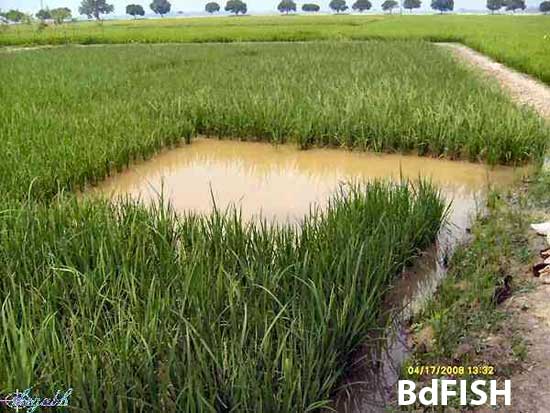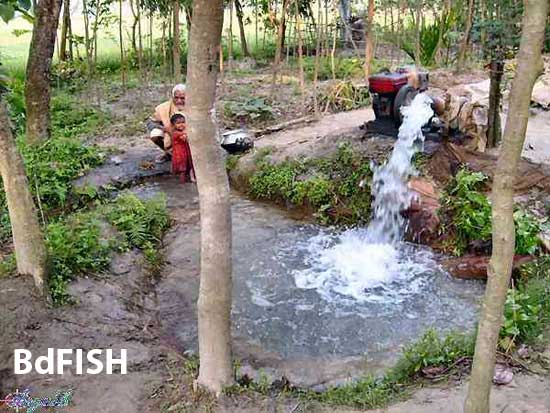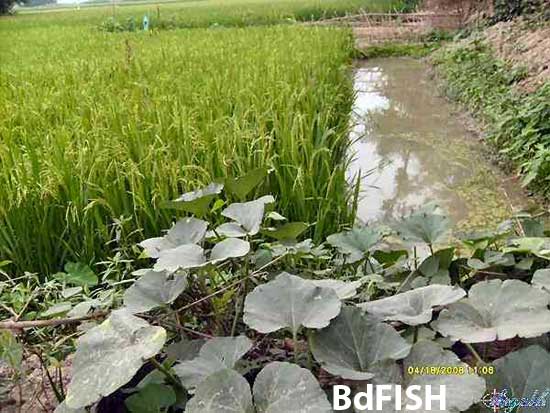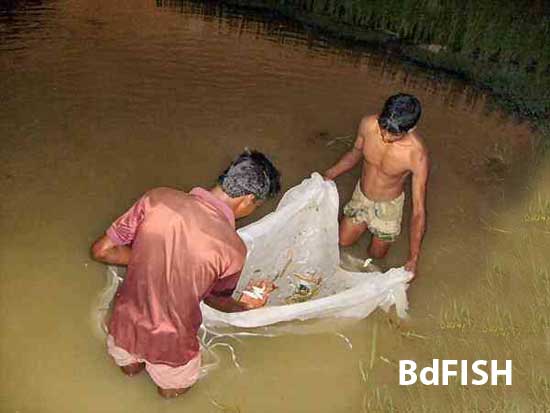
Intro:
Integrated fish farming is a technique of fish culture with other organisms (animal/s or plant/s). Major objective of this technique is to get maximum output through involving minimum input supply in minimum time duration. Rice-Fish farming is the culture of rice-fish in a same piece of land. In Bangladesh, number of fishpond may be fixed but amount of paddy/rice field is much and a large portion of these fields are suitable for Rice-Fish culture. More production can be achieved in Rice-Fish culture in comparison to the rice culture alone.
Advantages of Rice-Fish culture:
- Production of fish as additional crop.
- Insect or pest that attacks the paddy can be controlled by stocked fish as fish takes those organisms as feed.
- Fecal or semi-fecal materials discharge from the fish body serve as fertilizer in the rice field as a result fertility of the field increase.
- More profitable than rice cultivation alone. 60% more profit in Boro season and 90% more profit in Aman season can be achieved.
- Easy technology and low cost involvement.
- Great acceptability especially to the rural people.
History and Development of Rice-Fish culture:
History of Rice-Fish culture is quite old and first started in ancient China about 2000 years ago. In course of time, this practice became introduced in Indonesia, Vietnam, Thailand, India and many other countries of the world. Lately, Azolla is cultured with Rice-Fish in China.
Traditional system of Rice-Fish culture:
In traditional culture system, several small ditches were prepared in the rice field and tree branches or bushes were placed for creating suitable artificial habitat to attract wild fishes. Sometimes fry of Carpio was stocked. Production was much low and it was about 50 kg per hectare.
Recent Developments:
Since nineties, several NGOs (Non Government Organizations) worked on Rice-Fish culture and both nursery and table fish are producing through this technique. Prawn like Macrobrachium rosenbergii is now also stoked for more profit and diversified product. Major fish species used are Labeo rohita (Rui), Catla catla (Catla), Cirrhina mrigala (Mrigel), Cyprinus carpio (Common and Mirror carp), Hypophthalmichthys molitrix (Silver carp), Tilapia sp. (Tilapia), Thai barb (Puntius gonionotus) and giant freshwater prawn (M. rosenbergii). Production is much higher than traditional system which is about 200 kg/ha.

Culture technique:
Fish culture with rice can be practiced in two ways- (1) rice-fish together in the same time (concurrent system) and (2) fish culture after harvesting rice (alternative system). In Bangladesh, generally this culture is practiced during Boro and Amon seasons. Suitable paddy type are-
Amon season : BR-11, BR-3, BR-30
Boro season : BL-16, BR-14
Culture of Rice-Fish together/Concurrent system: Generally practiced during Aman season in moderate to low paddy fields where water logging exists for 4-5 months naturally. Mirror carp and Thai barb are highly suitable for this practice but Tilapia or giant freshwater prawn can also be stocked with rice.
Fish culture after harvesting rice/alternative system: In this technique, fish are stocked in the paddy field after harvesting rice from the land. 6-7 months rearing of fish is possible by this way until rice plantation in the next season. Carp and barb species are suitable for stocking but grass carp (Ctenopharyngodon idella) can also be stocked. In case of grass carp stocking, precaution must be taken so that this fish can not eat young paddy.
Management steps:
a. Site selection and infrastructure building:
Site selection:
Water holding capacity of the selected plot’s soil must be good enough so that soil can hold water easily. Loamy or Clay-loamy soils are suitable for Rice-Fish culture. Selected plot should be low land and would contain water naturally for 7-10 months but must be secure from flood.
Infrastructure building:
Preparation of ditch and canal: At least a single ditch must be excavated in the rice field. Ditch should be of 3 feet water depth and can be 20% of the total field. This ditch will serve as shelter during hot season and make the harvesting easier. Several canals should be dug connecting ditch for free movement of fishes. Enough space must be left from land boundary so that dyke would not be broken. Ditch can be excavated in different position of the plot, some models are shown in the following figure.

Prooviding shelters for prawn: If someone wishes to stock prawn, then it is essential to provide some sort of substances which will serve as shelter for prawn. As prawn change its shell as growth advances (i.e. molting), it remains very susceptible to attack by other animals during molting period. Substances like coconut branch, palm branch or other tree branches can be supplied in the water for this purpose.
Creation of shade facilities: Shading is essential during high temperature and excess rainfall to save stocked species from unfavorable condition. Bamboo splits made mat, coconut or palm branch, cultivation of vegetable on rack on dyke can provide shade for the fishes.
b. Land preparation:
Border, dyke of land needs to be reconstructed if necessary. Weeds must be controlled and excess bottom mud must be removed. Predatory or unwanted fish species or other animal will be removed from the culture plot. Lime (1 kg/decimal; 2-3 kg/decimal for red soil) and fertilizers (usually cow dung, urea, and TSP) should be applied at a proper dose.
c. Nursery preparation:
It is an optional measure to prepare nursery area for temporary rearing of prawn or shrimp PL. 10-15% area of total field can be used as nursery. Nursery is often refers to as ‘Pocket Gher’. Generally shrimp or prawn PL reared in this nursery for 20-25 days. Stocking density should be 1500-2000 PL (1.5-2 cm size) per decimal area.
d. Transfer or stocking of prawn juvenile / fish to the rice-field:
Prawn PL needs to be stocked during evening as they are more sensitive than fin fish fry and can tolerate sudden changes in temperature and dissolved oxygen level in water. If they stocked during evening the stocked PL will get more time at night to adopt with the environment. Stocking density will be 10000-15000 PL per hectare area.
Other fin fish fry can be stock in the morning or in the afternoon time. Stocking density will be 20-25 individual per decimal for monoculture depending on level of water and other related factors. In case of mixed stocking, 20 individuals should be stocked. Stocking size should be 5-8 cm depending on types of fish species. One thing should be kept in mind, that it would not be a very wise decision to stock prawn and other bottom dweller fin fish species together as they can make competition each other for food and space.
e. Other management:
Paddy: Naturally grown weeds in the field must be eradicated and other harmful insect must be controlled.
Fish and prawn: Supplementary feed needs to be supplied for faster growth of stocked species. Supplementary can be applied at 3-5% weight of stocked biomass. If phytoplankton feeder fish like Silver carp stocked in the rice field, no extra feeds required for this fish.
f. Vegetable production:
Vegetable can be planted on dyke or by making rack made of available materials (bamboo sticks, vegetable branches without leaves etc.).

g. Sampling and Harvesting:
Regular sampling of stocked species is very much necessary to monitor growth, or to test disease. This can be done by using seine net in ditch after gathering the fish there (in ditch).

For maximum benefit, stocked species must be harvested in proper time. 100% harvesting is very much possible by draining out (dewatering) the water of the field.
Visited 11,332 times, 1 visits today | Have any fisheries relevant question?

